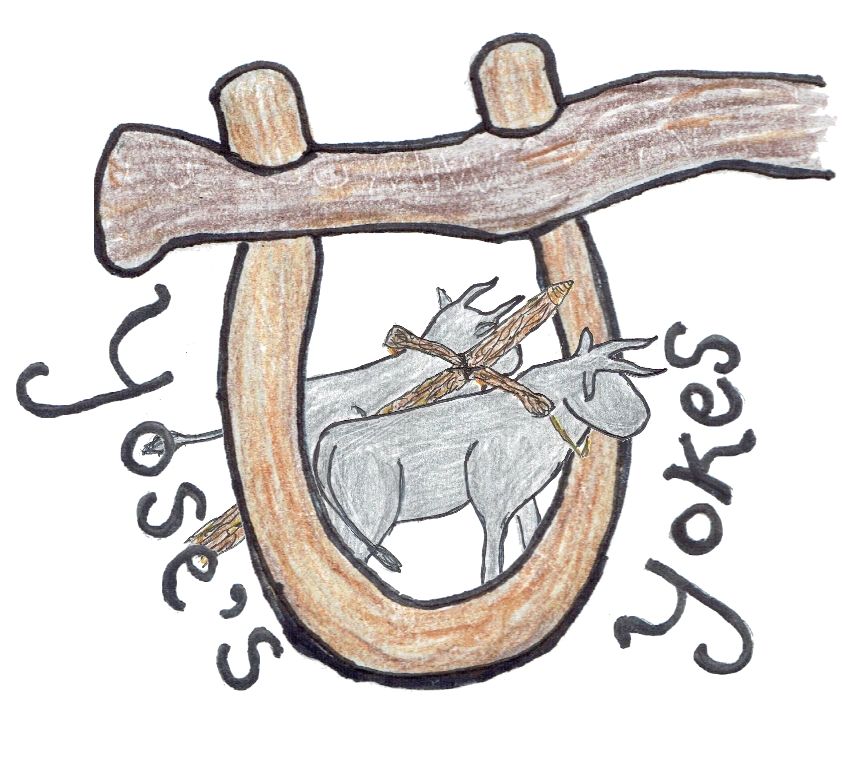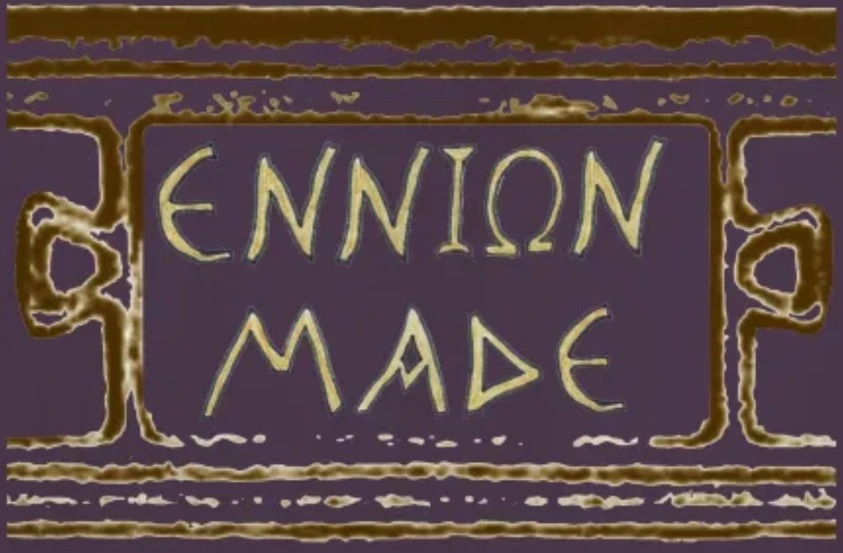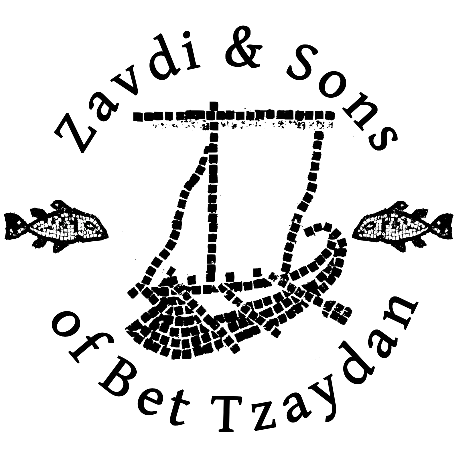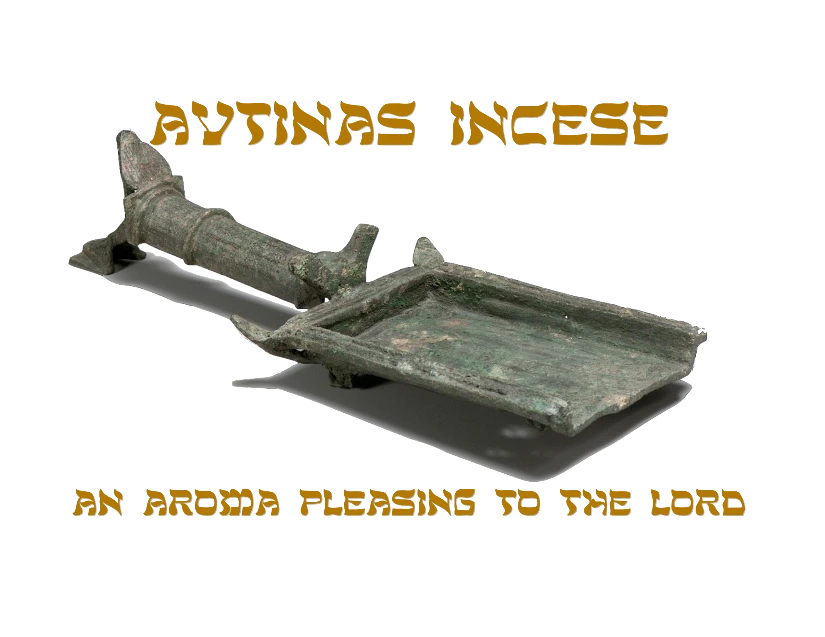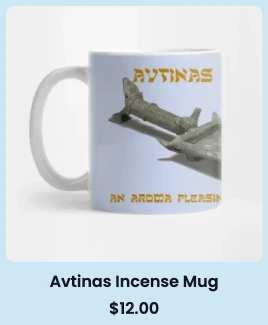Jerusalem Perspective’s online content is brought to you in part with support from our first-century sponsors.[1]
Listed below are the artisans and tradesmen who have been loyal and enthusiastic sponsors of Jerusalem Perspective, LLC since the first century C.E. We appreciate their sponsorship and hope you will reward them with your custom by purchasing some of their products, which appear below.

Yose’s Yokes & Agricultural Implements[2]
Conveniently located near the town of Tzippori in the village of Natzerat,[3] a local craftsman, Yose ben Eli,[4] carves the finest yokes in the Galil for your oxen.[5] Active in the local synagogue and knowledgeable about halakhic matters,[6] Yose the yoke-maker has a good name in the community and a trustworthy reputation[7] in his trade. He is training up his sons as apprentices to carry on the business after him.[8] Whether your beasts are plowing the fields or pulling a heavy cartload, Yose’s carefully designed and handcrafted yokes rest easy on your draft animals’ shoulders to make their burdens feel light.[9]
|
To purchase a Yose’s Yokes mug, sticker, magnet, tee shirt, etc., click on the icon to the right or visit the JP Dashery store at the following link: https://jerusalemperspective.dashery.com/products/83655506-yoses-yokes-mug. |

Ennion Molded Glassware[10]
Using the latest in glass blowing technology, Ennion’s finely crafted glassware is essential for your refined dining experience.[11] Ennion’s glassblowing workshop and storefront, located in Sidon, ships its delicate yet durable products throughout the Roman Empire.[12] Ennion’s signed goblets, pitchers, bowls and dishes grace the homes of high priests, the palaces of kings, and the mansions of the Empire’s most elite citizens. Glass blowing has reached a new level of refinement with Ennion’s patented technique of blowing the glass into molds of the most intricate and aesthetically pleasing designs. Each item is signed by Ennion, the world’s foremost glassblower, so you won’t forget that yours is an authentic Ennion masterpiece: “Ennion Made.”[13]
|
To purchase an Ennion Molded Glassware mug, sticker, magnet, tee shirt, etc., click on the icon to the right or visit the JP Dashery store at the following link: https://jerusalemperspective.dashery.com/products/83355587-ennion-made-it-mug. |

Zavdi & Sons of Bet Tzaydan: Nets and Fishing Tackle[14]
Specializing in trammel nets, drag nets, and cast nets,[15] Zavdi & Sons[16] offer a full array of tackle and nautical gear for fishermen on the Lake of Gennesar.[17] Stone weights for nets, fishing hooks, basalt anchors, and netting needles[18] are all available on our waterfront location in the village of Bet Tzaydan.[19] Zavdi & Sons also offers ropes, sails, replacement oars and sealant for your boat so that you’ll stay afloat if your crew is caught in a sudden storm.[20] Whether you’re hauling in musht or schools of sardines, or angling for biny[21] you won’t catch a bad fish[22] with Zavdi & Sons all-weather fishing gear.
|
To purchase a Zavdi & Sons mug, sticker, magnet, tee shirt, etc., click on the icon to the right or visit the JP Dashery store at the following link: https://jerusalemperspective.dashery.com/products/83358801-zavdi-and-sons-mug. |

Avtinas Incense[23]
For generations the Avtinas family of priests has carefully guarded the secret recipe[24] for the incense offered twice daily on the golden altar in the inner sanctum of the Temple.[25] Burning incense on the golden altar is a once in a lifetime experience for the sons of Aaron,[26] which is made possible by the Avtinas family’s secret recipe. Blended with the finest ingredients consisting of frankincense and other aromatic spices,[27] Avtinas Incense provides the Temple with an incense whose smoke rises up in a beautiful column[28] to create a pleasing aroma to the Lord.
|
To purchase an Avtinas Incense mug, sticker, magnet, tee shirt, etc., click on the icon to the right or visit the JP Dashery store at the following link: https://jerusalemperspective.dashery.com/products/83656529-avtinas-incense-mug. |

- [1] The first-century sponsors listed here are, of course, fictional and intended to be in good fun. While tongue-in-cheek, these “advertisements” are also intended to be informative about aspects of daily life in the first century. Purchase of items with our sponsors’ fanciful logos does, however, support the work of JP while also bringing a smile to the buyer’s face. ↩
- [2] The logo, drawn by Joshua N. Tilton is based on an ancient Egyptian model of a man plowing with a team of oxen belonging to the collection of the Metropolitan Museum of Art in New York [https://www.metmuseum.org/art/collection/search/544255]. ↩
- [3] Reconstructing the Hebrew name of Nazareth is complicated in part because ancient Hebrew texts are unvocalized. So although the Hebrew name נצרת is attested in inscriptions, pronunciation of the name must be guided in part by the vowels supplied in the Greek form of the name. For a discussion of the issue, see David N. Bivin and Joshua N. Tilton, “Yeshua’s Immersion,” The Life of Yeshua: A Suggested Reconstruction (Jerusalem Perspective, 2020) [https://www.jerusalemperspective.com/20465/], Comment to L6. They opt for the vocalization נָּצְרַת (nā·tze·RAT). ↩
- [4] “Yose” is a shortened form of the name “Yosef” (“Joseph”).According to Luke’s genealogy Joseph’s father was Eli (Luke 3:23). Matthew’s genealogy gives Joseph’s father’s name as Jacob (Matt. 1:16). The two genealogies are irreconcilable. ↩
- [5] The Gospel of Matthew states that Joseph was a craftsman of some kind (Matt. 13:55). The Greek word is τέκτων (TEK·tōn), which often refers to a wood worker. An early Christian tradition repeated by Justin Martyr (Dial. §88) claims that Joseph carved yokes for oxen. ↩
- [6] David Flusser drew attention to a Jewish tradition that carpenters were often regarded as particularly learned. See David Flusser, Jesus (3d ed.; in collaboration with R. Steven Notley; Jerusalem: Magnes, 2001), 33. ↩
- [7] According to Matt. 1:19, Joseph was reputed to be a righteous man. ↩
- [8] Parallel to Matt. 13:55, Mark 6:3 identifies Jesus as the carpenter. ↩
- [9] Cf. Matt. 11:30. On this saying, see David N. Bivin, “Jesus’ Yoke and Burden,” Jerusalem Perspective (2004): [https://www.jerusalemperspective.com/4435/]. ↩
- [10] The Logo is based on the design surrounding Ennion’s signature on one of his fine glassware specimens. ↩
- [11] A glassblower named Εννιων (Enniōn, “Ennion”) was famed throughout the Roman Empire in the first half of the first century C.E. for the fine glassware he produced with a novel technique of blowing glass into molds, which gave the glassware their shape. ↩
- [12] Specimens of Ennion’s work, which are identifiable because they are signed, have been found in luxurious homes throughout the Roman Empire. ↩
- [13] Ennion’s glassware frequently bore inscriptions that read ΕΝΝΙΩΝ ΕΠΟΙΗCΕΝ (“Ennion Made”) and ΜΝΗ[C]ΘΗ Ο ΑΓΟΡΑΖΩΝ (“Let the purchaser remember”). ↩
- [14] The Zavdi & Sons logo features details of mosaics discovered around the sea of Galilee depicting fish (Tabgah) and a fishing boat (Magdala), similar to the first-century fishing boat discovered on the shore of the lake near Nof Ginnosar. ↩
- [15] On the different styles of nets ancient fishermen on the Sea of Galilee used to catch fish, see Mendel Nun, “‘Let Down Your Nets,’” Jerusalem Perspective 24 (1990): 11-13 [https://www.jerusalemperspective.com/2451/]. ↩
- [16] The Greek name Ζεβεδαῖος (Ze·be·DAI·os, “Zebedee”), which occurs in the Gospels, could represent the Hebrew name זְבַדְיָה (ze·vad·YĀH) or זַבְדִּי (zav·DI). See David N. Bivin and Joshua N. Tilton, “Choosing the Twelve,” The Life of Yeshua: A Suggested Reconstruction, Jerusalem Perspective (2015) [https://www.jerusalemperspective.com/13905/], Comment to L24. ↩
- [17] “Lake of Gennesar” is the name of the Sea of Galilee that was current in the first century. The name “Sea of Galilee” appears to have been an early Christian innovation that was unknown in the time of Jesus. See R. Steven Notley, In The Master’s Steps (Jerusalem: Carta, 2014), 25-28. In the synoptic tradition “Sea of Galilee” occurs in the Gospels of Mark and Matthew, but not in the Gospel of Luke. The term “Sea of Galilee” also occurs in the Gospel of John. ↩
- [18] A JP article by Mendel Nun shows a drawing of a Roman-period netting needle discovered in Magdala. See Mendel Nun, “Has the Lost City of Bethsaida Finally Been Found?” Jerusalem Perspective 54 (1998): 12-31 [https://www.jerusalemperspective.com/905/]. ↩
- [19] The anglicized name “Bethsaida” reflects the Greek name Βηθσαϊδά (Bēth·sa·i·DA), familiar from most NT references to the town. However, a variant of the name, Βηθσαϊδάν (Beth·sa·i·DAN) with a final nu, occurs in Jesus’ woes against Capernaum, Chorazin, and Bethsaida(n). The name of a village called צַיְדָן (tzay·DĀN)—note the final nun—is known from rabbinic sources, which may be identical with Bethsaida. See David N. Bivin and Joshua N. Tilton, “Woes on Three Villages,” The Life of Yeshua: A Suggested Reconstruction, Jerusalem Perspective (2023) [https://www.jerusalemperspective.com/22206/], Comment to L6. ↩
- [20] On storms on the Sea of Galilee, see Mendel Nun, “Fish, Storms and a Boat,” Jerusalem Perspective 25 (1990): 3-5 [https://www.jerusalemperspective.com/2456/]. ↩
- [21] The various species of commercial fish in the Sea of Galilee are discussed by Mendel Nun in his JP article, “Fish and the Sea of Galilee,” Jerusalem Perspective 22 (1989): 8-9 [https://www.jerusalemperspective.com/4311/]. ↩
- [22] “Bad fish” alludes to Jesus’ parable of the drag net, in which the “good” (i.e., kosher) fish are separated from the “bad” (i.e., non-kosher) fish, namelyh catfish. See Mendel Nun, “The Kingdom of Heaven Is Like a Seine,” Jerusalem Perspective 23 (1989): 3-4 [https://www.jerusalemperspective.com/2411/]. ↩
- [23] The logo includes the image of an incense shovel, similar to what was used in the Temple in Jerusalem. ↩
- [24] Rabbinic sources recall that the House of Avtinas, which made the incense for the Temple, was unwilling to divulge its secret recipe to anyone outside the family. While the Mishnah criticized the House of Avtinas for their secrecy (m. Yom. 3:11), the Tosefta praised them for their scrupulousness lest the secret blend for the Divine Service be used for idolatrous worship (t. Yom. 2:6). According to the Tosefeta, women of the House of Avtinas even refrained from wearing perfumes of any kind so as to avoid the impression that they had used their family’s special blend of incense for secular purposes. ↩
- [25] See Exod. 30:7-8. ↩
- [26] According to the Mishnah the priests drew lots to see who would present the incense offering in the Temple. Only priests who had not done so before were allowed to enter the lot. See Shmuel Safrai, “Zechariah’s Prestigious Task,” Jerusalem Perspective 18 (1989): 1, 4 [https://www.jerusalemperspective.com/2326/]. ↩
- [27] For the ingredients of the Temple’s incense, see Exod. 30:34. On frankincense, see Joshua N. Tilton, “‘Look at…all the trees’: Trees in the New Testament Gospels,” Jerusalem Perspective (2024) [https://www.jerusalemperspective.com/28823/]. ↩
- [28] According to rabbinic tradition the smoke produced by the House of Avtinas rose up in a column before dissipating downwards. Other makers of incense could not reproduce this particular quality. See t. Yom. 2:6. ↩


